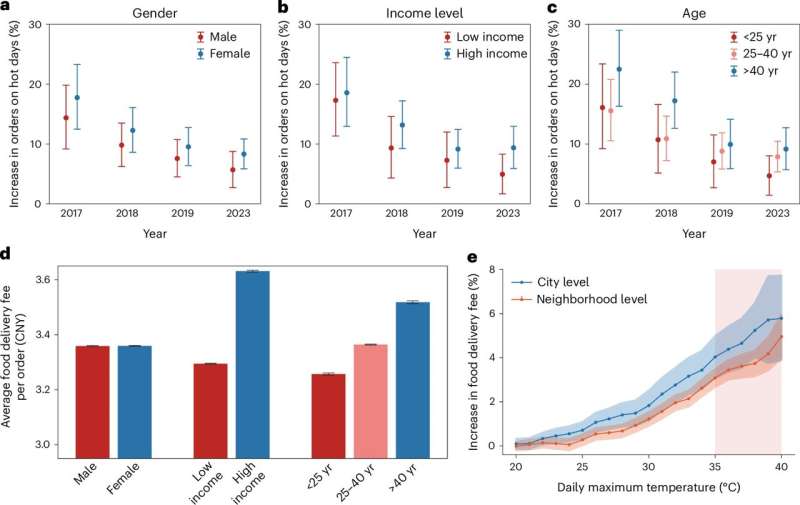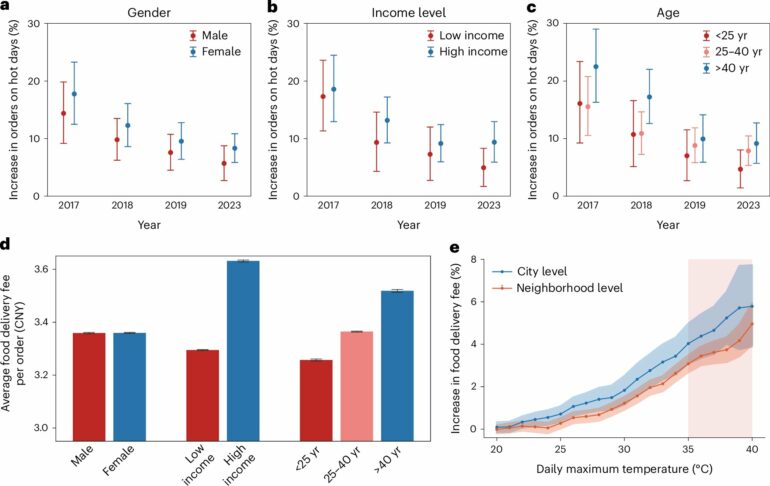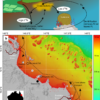City dwellers avoid exposure to extremely hot weather events by ‘ordering in’ from food delivery services, a new study shows.
The behavior, observed mostly among female, high-income, and older groups, forms part of an emerging heat adaptation strategy by urban residents, according to the international team of researchers.
Their study highlights the opportunities for mitigating exposure to high temperatures caused by climate change with food delivery services, particularly for vulnerable groups such as the elderly, those with a low-income, and people with limited mobility.
However, the benefits of the reduced heat exposure are not equally distributed across different populations, the researchers warn.
Their findings, titled published in Nature Cities, instead reveal increased exposure being transferred to delivery workers from consumers, highlighting a growing need for occupational health insurance in the context of climate change.
Author Dr. Daoping Wang, a lecturer in the Department of Geography at King’s College London, said, “Rising heat events caused by climate change are becoming more frequent, bringing with them real threats to people’s health. And, as a result, in cities, we are seeing these kinds of weather events imposing limits on residents’ outdoor activities.”
The team identified an increase in reliance on food delivery services during hot days, where temperatures exceeded 30°C by analyzing extensive food delivery records from 100 Chinese cities between 2017–2023.
Their analysis revealed significant variations in the response to heat across demographic groups with stronger adaptation observed in females, high-income, and older residents.

Heterogeneous response to heat stress of users over different demographic groups. © Nature Cities (2025). DOI: 10.1038/s44284-024-00172-z
Dr. Wang added, “With emerging food delivery services serving more than 500 million people in China, these provide a way for people to ‘order in’ their food to avoid exposure to the elements.
“Until now though, the effects on both consumers and delivery workers remain unknown, primarily hindered by the limited data availability. Our unique dataset developed in collaboration with the largest food delivery platform in China helps fill this gap.”
The research provides unprecedented nationwide empirical evidence of food delivery as a heat adaptation strategy, highlighting demographic disparities in its benefits and the social justice concerns related to delivery workers’ exposure to heat.
Co-author Dr. Pan He, a lecturer at Cardiff University’s School of Earth and Environmental Sciences, added, “Our study quantifies the benefits of ordering in, showing that residents can avoid an average of 3.6 hours annually of walking in extreme heat, where conditions exceed 35°C, by using food delivery.
Discover the latest in science, tech, and space with over 100,000 subscribers who rely on Phys.org for daily insights.
Sign up for our free newsletter and get updates on breakthroughs,
innovations, and research that matter—daily or weekly.
“However, these benefits are unevenly distributed, and a substantial portion of the heat exposure risk is transferred to delivery workers, highlighting significant social inequality in these practices.
“As extreme weather events increase under climate change, our study offers crucial evidence that food delivery services can help mitigate heat exposure, particularly among vulnerable groups.”
“In order to fully realize these benefits, policymakers must consider measures to encourage equitable access to services and, at the same time, implement protections for delivery workers,” conclude Yunke Zhang and Yong Li, team members from Tsinghua University.
The researchers now plan to assess the environmental impact of food delivery, including plastic waste and emissions, and investigate more equitable solutions for protecting delivery workers, including heat subsidies and technological innovations like unstaffed deliveries.
More information:
Yunke Zhang et al, Urban food delivery services as extreme heat adaptation, Nature Cities (2025). DOI: 10.1038/s44284-024-00172-z
Provided by
Cardiff University
Citation:
Too hot to go outside: Female, high-income and older groups most likely to ‘order in’ during heat waves (2025, January 6)



